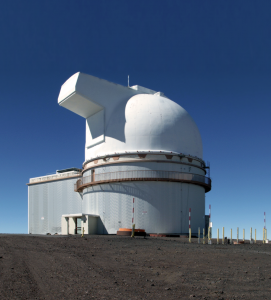By Staff Reports
(Hawaii)– The University of Hawaiʻi’s 88-inch telescope is celebrating its golden anniversary on June 26. Often called the UH88, the telescope was dedicated in 1970, beginning decades of incredible scientific output, and ushering in an era of unparalleled astronomy from Maunakea. Now, 50 years later, the observatory continues to modernize and pave the way for the others.
When the UH88 first opened, digital cameras did not exist. Astronomers spent long, cold nights at the summit of Maunakea, manually guiding the telescope, using photographic plates and later analog electronic detectors to observe stars, galaxies and planets. Today, the observatory is undergoing a major renovation to go fully robotic. Automated control systems along with new hardware and technologies will be added so multiple cameras can be utilized in a single night of observing. It is also the only telescope on Maunakea where the science use of the facility is decided entirely by UH astronomers. As a result, UH students can obtain a significant fraction of observing time.
“These are projects where you need a lot of time to study many, many objects, or to monitor objects over long periods of time. This type of research is really hard to do on other telescopes so the facility gives our students a real advantage,” said UH88 Director Mark Chun.
When it first opened, the 88-inch was the largest telescope on Maunakea, and the eighth largest in the world. Today, it is the smallest operational telescope on the mountain. However, by adapting how it operates and by deploying innovative instruments, the 88-inch continues to be scientifically productive.
UH88’s most notable discoveries
Throughout the past 50 years, the UH88 has been used to make important discoveries and develop tools that astronomers use at telescopes around the world and in space. One of its most famous discoveries is the Kuiper Belt—distant objects beyond Neptune in the outer solar system. Former UH Institute for Astronomy (IfA) astronomers Dave Jewitt and Jane Luu discovered the doughnut-shaped region in 1992. Starting in the 1980s, they used the UH88 to search for Pluto-like objects and found dozens. Today, nearly 2,000 objects are known to orbit in the Kuiper Belt. The discovery led astronomers to realize that Pluto is the largest and closest of these objects, which resulted in its demotion from being a full-fledged planet.
“The Kuiper Belt has revolutionized our understanding of the solar system. Not only does it answer a long-standing question about where comets come from, but the structure of the Belt has given us a new picture of solar system formation and evolution,” explained Jewitt.
UH88 shifts to robotic operations
In 2008, the UH88 was the first telescope on Maunakea to switch to full remote observing so astronomers in Honolulu, Hilo or even around the world could observe without being there. The UH88 facility will now take the next step and move to robotic operations where even the choices of observations will be done entirely by a computer. This change will allow the facility to quickly change between targets, science programs and instruments allowing it to follow-up and study in detail the discoveries from the sky survey telescopes such as the IfA Pan-Starrs, ATLAS and ASAS-SN projects. This rapid response capability will revolutionize the science that the facility can do. A new Robo-AO2 system will bring to the facility robotic imaging that will deliver images with resolution similar to those from Hubble Space Telescope. The capability will provide high-resolution images at visible wavelengths where it is difficult for larger telescopes’ adaptive optics system to operate. These new directions will ensure that the UH88 will remain productive for many years to come.
For more on the UH88’s contributions to astronomy go to the IfA website.

